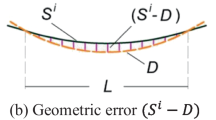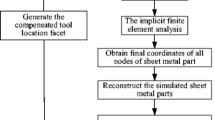Abstract
Iterative methods based on finite element simulation are effective approaches to design mold shape to compensate springback in sheet metal forming. However, convergence rate of iterative methods is difficult to improve greatly. To increase the springback compensate speed of designing age forming mold, process of calculating springback for a certain mold with finite element method is analyzed. Springback compensation is abstracted as finding a solution for a set of nonlinear functions and a springback compensation algorithm is presented on the basis of quasi Newton method. The accuracy of algorithm is verified by developing an ABAQUS secondary development program with MATLAB. Three rectangular integrated panels of dimensions 710 mm ×750 mm integrated panels with intersected ribs of 10 mm are selected to perform case studies. The algorithm is used to compute mold contours for the panels with cylinder, sphere and saddle contours respectively and it takes 57%, 22% and 33% iterations as compared to that of displacement adjustment (DA) method. At the end of iterations, maximum deviations on the three panels are 0.618 4 mm, 0.624 1 mm and 0.342 0 mm that are smaller than the deviations determined by DA method (0.740 8 mm, 0.740 8 mm and 0.713 7 mm respectively). In following experimental verification, mold contour for another integrated panel with 400 mm×380 mm size is designed by the algorithm. Then the panel is age formed in an autoclave and measured by a three dimensional digital measurement devise. Deviation between measuring results and the panel’s design contour is less than 1 mm. Finally, the iterations with different mesh sizes (40 mm, 35 mm, 30 mm, 25 mm, 20 mm) in finite element models are compared and found no considerable difference. Another possible compensation method, Broyden-Fletcher-Shanmo method, is also presented based on the solving nonlinear functions idea. The Broyden-Fletcher-Shanmo method is employed to compute mold contour for the second panel. It only takes 50% iterations compared to that of DA. The proposed method can serve a faster mold contour compensation method for sheet metal forming.
Similar content being viewed by others
References
ZENG Yuansong, HUANG Xia, HUANG Shuo. The research situation and the developing tendency of creep age forming technology[J]. Journal of Plasticity Engineering, 2008, 15(3): 1–8. (in Chinese)
YANG Xiang’an, RUAN Feng. A die design method for springback compensation based on displacement adjustment[J]. International Journal of Mechanical Sciences, 2011, 53(5): 399–406.
KARAFILLIS A P, BOYCE M C. Tooling and binder design for sheet metal forming processes compensating springback error[J]. Journal of Machine Tools and Manufacture, 1995, 36(4): 503–526.
KARAFILLIS A P, BOYCE M C. Tooling design in sheet metal forming using springback calculations[J]. International Journal of Mechanical Sciences, 1992, 34(2): 113–131.
KARAFILLIS A P, BOYCE M C. Tooling design accommodating springback errors[J]. Journal of Materials Processing Technology, 1992, 32(1–2): 499–508.
GAN Wei, WAGONER R H. Die design method for sheet springback[J]. International Journal of Mechanical Sciences, 2004, 46(7): 1097–1113.
GAN WEI, WAGONER R H, MAO Kunming, et al. Practical methods for the design of sheet formed components[J]. Journal of Engineering Materials and Technology, 2004, 126(4): 360–367.
YANG Xiang’an, RUAN Feng. Analysis on springback compensation direction for die-face adjustment[J]. Journal of Plasticity Engineering, 2010, 17(2): 6–10. (in Chinese)
HAN Jinquan, WAN Min, LI Weidong. Surface improvement based on springback compensation for aircraft skin stretching tool[J]. Chinese Journal of Mechanical Engineering, 2009, 45(11): 184–188. (in Chinese)
LINGBEEK R, HUETINK J, OHNIMUS S, et al. The development of a finite elements based springback compensation tool for sheet metal products[J]. Journal of Materials Processing Technology, 2005, 169(1): 115–125.
CHAI Haixiao. Research for stamping springback control method based on compensation of geometry and process[D]. Hangzhou: Zhejiang University, 2006. (in Chinese)
YANG Weijun, LI Dongsheng, LI Xiaoqiang, et al. Tool surface design method with rapid springback compensation for fluid-cell forming process[J]. Chinese Journal of Mechanical Engineering, 2011, 47(12): 67–73. (in Chinese)
HUANG Lin, WAN Min, WU Xiangdong, et al. Prediction of springback and tool surface modification technology for age forming of integral pane[J]. Chinese Journal of Aeronautics, 2009, 30(8): 1531–1536. (in Chinese)
HUANG Lin, WAN Min. Compensation algorithm for springback in age forming for aluminum alloy thick plate[J]. Chinese Journal of Aeronautics, 2008, 29(9): 1406–1410. (in Chinese)
ZHU Jiazan. Age forming simulation and die design of integral panel of aluminum alloy[D]. Xi’an: Northwestern Polytechnical University, 2012. (in Chinese)
TAN Haibing. Molded surface design research of the integral skin-panel based on aging forming[D]. Xi’an: Northwestern Polytechnical University, 2013. (in Chinese)
GAN Zhong, XIONG Shipeng, ZHU Jiazan, et al. Structure of tool surface for age forming of integral panel of aluminum alloy[J]. Chinese Journal of Mechanical Engineering, 2012, 48(16): 74–79. (in Chinese)
LIU Jing. Review of registration based on CAD model[J]. Machine Tool & Hydraulics, 2007, 35(9): 231–232. (in Chinese)
ZHANG Lei. Age forming simulation and springback prediction of aluminum alloy 2124[D]. Xi’an: Northwestern Polytechnical University, 2011. (in Chinese)
Author information
Authors and Affiliations
Corresponding author
Additional information
XIONG Wei, born in 1983, is currently an instructor at Department of Mechanical Engineering, Guilin University of Aerospace Technology, China. He received his PhD degree from Northwestern Polytechnical University, China, in 2014. His research interests include sheet metal forming and quantitative methods.
GAN Zhong, born in 1969, is currently an associate professor and a MS supervisor at School of Mechanical & Electrical Engineering, Northwestern Polytechnical University, China. He received his PhD degree from Northwestern Polytechnical University, China, in 2011. His research interest is age forming.
XIONG Shipeng, born in 1989, is a master candidate at School of Mechanical & Electrical Engineering, Northwestern Polytechnical University, China. His main research interest is age forming.
XIA Yushan, born in 1987, is a master candidate at School of Mechanical & Electrical Engineering, Northwestern Polytechnical University, China. His main research interest is age forming.
Rights and permissions
About this article
Cite this article
Xiong, W., Gan, Z., Xiong, S. et al. Rapid springback compensation for age forming based on quasi Newton method. Chin. J. Mech. Eng. 27, 551–557 (2014). https://doi.org/10.3901/CJME.2014.03.551
Received:
Revised:
Accepted:
Published:
Issue Date:
DOI: https://doi.org/10.3901/CJME.2014.03.551




